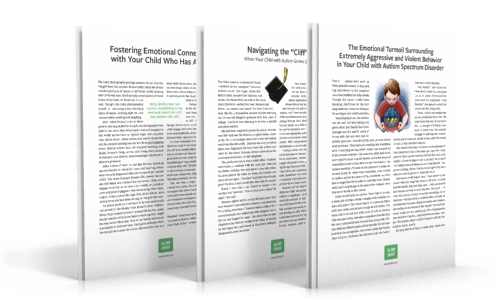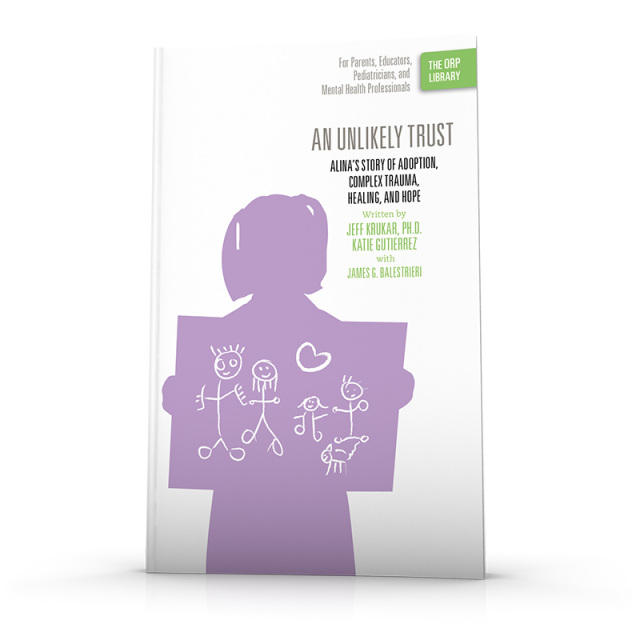Swing Low, Swing High: Parents Moving into Emotional Scaling for their Daughter
Written By: Nancy Yeang
Resource Creation By: Bridget Morton
Design By: Christy Bui, Sunny DiMartino
Stacy screamed at the top of her lungs. I sprang into high alert mode and took a step back. She threw herself on the tiled kitchen floor and started rolling around, flailing her arms and kicking her legs. Her foot struck the kitchen chair, causing it to crash to the floor next to her. Startled, she took a gulp of air and screamed louder.
“Stacy, you’re starting to get very, very angry right now,” I said, stating the obvious emotion for her at the advice of our psychotherapist. “I can tell you’re not happy, but I don’t want you to hurt yourself.”
“Where’s Daddy?” Stacy yelled. “Where’s Daddy??”
“He’s stuck in traffic, sweetie, and will be home any minute,” I explained, silently hoping that was the truth.
Stacy let out another ear-splitting scream and began to kick the fallen chair next to her.
Just a moment ago, while I was setting the table and getting food ready for dinner, Stacy came into the kitchen asking if she could eat. She was hungry and wanted to eat immediately. I told her that we should wait until her father came home so we could eat together as a family. Jake had called me saying there was a traffic jam on the freeway and that he would be a little bit late. But to Stacy, a little bit seemed like forever.
When Stacy finally realized that she wasn’t going to eat when she wanted to, the outburst began. Because of the insufficient care, deprivation, and inconsistent caregiving she had faced as a very young child in an orphanage, food was always a major trigger for her. She was a very inflexible thinker, and she also didn’t have a good concept of time. Having dinner delayed only a few minutes evoked the same level of anxiety as having to go through an entire day without food would for any child, even one without Reactive Attachment Disorder. Stacy’s anxiety most often manifested as anger, rage, and physical aggression.
Before I could think of the next step, Stacy rolled across the floor, closer to me, and kicked my shin.
“Ah!” I yelled out from the sharp pain. “You just kicked me! Why did you want to hurt me?” My outburst made Stacy scream even more. I needed to do something to get her to stop screaming before everything got worse, but I wasn’t quite sure what. Plus, I was starting to get really worried—and scared. Stacy looked like she was getting really upset.
Stacy kicked me again, this time with more of a shin kick to the side of my knee, which made me fall to the ground.
She reached down then and grabbed at my head. I felt the roots of my hair ripping from the scalp, and I wrapped my fingers around her hand to keep her from pulling harder. Don’t pull away… don’t pull away… stay calm and don’t pull away, I reminded myself because I didn’t want to lose a bunch of hair.
“Let me go!” Stacy screamed.
YOU need to let ME go, I thought as I clenched my teeth together to prevent myself from yelling again. I felt the heat rise up my body, and my frustration started to boil. As I wrestled with my daughter for the umpteenth time on the floor of my home, a thought entered my mind.
You can’t have a rational conversation with your child when she’s reached that irrational and aggressive state. The psychotherapist’s voice was suddenly in my head. Children with Reactive Attachment Disorder have a hard time expressing their thinking and emotions easily because they have underdeveloped social emotional skills that are needed to help them coordinate what they’re feeling internally with words they can use to express those feelings. This is even more difficult for kids with RAD, during times of stress, or when they feel overwhelmed, as is happening during extreme anger and rage. Your daughter was also brought up in an early life situation where the only effective and consistent way to have her needs met or addressed was through an expression of anger and rage. While the behavior we often see is aggression, the underlying emotions may be fear, sadness, or something else.
I took a deep breath and felt my arms trying to contain my daughter with my body. My knee throbbed from where she kicked me. I started thinking about what led to her escalating aggression.
She’s hungry. She’s frustrated because she couldn’t eat. The chair toppled over. Maybe she felt guilty for hitting me. Maybe she’s scared because I’m holding her right now.
I felt the tears well up in my eyes because I should have tried to see what Stacy was feeling instead of reacting to her behavior. Stacy was still yelling, but I removed my hands from around her legs so she could be free from me. She still had one hand gripping a chunk of my hair, but I gently took her hands in my own and looked her in the eyes. She looked away but stopped yelling for a moment.

“I know you’re upset, and it’s okay, sweetie. Could you please let go of my hair now? It hurts me,” I said as calmly as I could, refusing to allow my tears to drop down my face.
Stacy loosened her grip, not completely letting go, but enough after a few seconds for me to take her hands away from my head and also let go of her. I stood up slowly, holding on to a chair for support because my leg hurt.
Be present in the moment and stay as calm as possible, the psychotherapist’s words floated through my head again. Your daughter will mirror your physiology first—if you want her to be calm, you absolutely must be calm yourself. Shoulders down and relaxed, a pleasant look on your face, even if you’re reeling inside. Assume a passive, low, non-threatening position.
I had to sit in the chair while Stacy stood, and I looked nonchalantly in her direction, secretly scanning the area to make sure nothing else was around for her to grab and throw or use as a weapon. She eyed me curiously, and eventually her screams subsided.
I heard the front door unlock and let out a sigh of relief as Jake walked through the door.
“Stacy, look, Daddy’s here,” I told her.
“I’m sorry I’m late,” Jake said as he came to the kitchen and saw my disheveled hair and the tears welling in my eyes. “Oh no, what happened?”
“We had a little problem this afternoon, but we’re doing better now,” I said, sitting in the chair and my heart rate starting to get back to normal. Thank God, he’s home, I thought. Stacy’s chest heaved as she tried to catch her breath.
“Honey….” Jake walked carefully toward Stacy. “How are you doing, sweetie?”
Stacey looked at him blankly, as though she didn’t remember what she was so upset about. She stood there and let Jake wrap his arms around her.
“How about we go out to the swing set for a little bit? You always feel better when you’re on your swing set,” Jake said as he slowly turned Stacy and himself toward the door.
“Okay,” she finally replied.
“Great. Let’s get you on the swing and then I will get you a glass of water,” Jake said.
Jake got Stacy on her feet and they walked out the back door. I had forgotten about the lure of the swing set. She could stay outside for hours swinging—she loved it. It was one of the few things we knew that would calm her down.
I leaned against the back of the chair and tried to relax. Jake pushed Stacy on the swing for ten minutes as I tried to regroup. He came back inside, leaving Stacy happy and smiling on the swing. I finally stood up.
“I’m really sorry I’m late,” Jake said as he pulled a chair next to me and put his arm around my shoulders. “There was a terrible accident and….”
“It’s okay. It’s not like you planned it,” I said, leaning against him. “I just froze again.”
“Were you able to talk to her at all, like we practiced?” Jake said.
“Only a little bit,” I said. “I tried to tell her that she was getting upset and started talking to her, but she knocked over a chair and kicked me in the shin and my knee. Then I grabbed her to make her stop being violent and she pulled my hair.”
“Oh honey,” Jake said, shaking his head.
The psychotherapist told us that one way to get Stacy to start understanding her emotions was to verbally label what she was feeling in an observational way, and tell her whether that emotion was on a lower, middle, or higher level. During the middle level and well before it hit a higher level, we could start providing her with different calming strategies so that she wouldn’t escalate and reach the highest level, which included aggression. The hard part would be getting to her while she was still rational in her thinking, so it was very important that we intervene during the lower to middle levels with suggestions and ideas for coping. The swing always seemed to work well for Stacy.
We were just learning to use the emotional intensity scale, and I was trying to help Stacy identify the beginning stages of her agitation and help her understand her emotions so that we could support her with emotion-regulation supports and strategies, with the eventual goal being that she could self-regulate and become more aware of how to self-calm when upset.
“I didn't know how to talk to her about this stuff and gave up. Plus, then things just got out of hand,” I said, feeling ashamed that I didn’t even have this conversation with my daughter.
“It’s okay, honey. We have an appointment with the therapist this week, right? We’ll just tell her we need her help in how to figure out the emotion scaling in a way that works for our daughter—and us. After all, that’s her job, right?” Jake said.
“I guess. That makes sense,” I said.
We sat in silence, watching Stacy use her legs to propel herself on the swing. Her eyes were now bright and she looked calm, going so high with her hair in the wind that it seemed like she might take flight. It was such a sudden change. She’d gone from screaming and violently kicking me and pulling my hair to being a calm, well-regulated, apparently care-free child on a swing set—at least for the moment. I felt like I was dealing with two completely different people, but I knew they were both really one, emotionally damaged, small being.
“We just have to take this one step at a time,” Jake said. “It seemed like she was starting to calm down when I came home.”
“She was, but I get really scared myself when I can’t stop, think, and assess everything going on in the moment, before she gets in a rage and gets violent,” I said.
“We’re all learning. The therapist told us that it takes time and we just need to be patient, take one step at a time, and keep trying,” Jake reassured me.
Stacy walked through the door.
“Can I eat now?” she said.
I gave her a smile. “Daddy’s home now, so yes.”
We went into the dining room to eat dinner as a family.
*This story is part of a series based on the experiences of educators, parents, and the staff of Genesee Lake School, a nationally recognized provider of services for students with special needs. GLS is part of MyPath, an employee-owned family of companies whose mission is to make a difference in the lives of people with disabilities.

Sign Up to Receive New Posts
We promise not to spam you or share your information with anyone. And you can unsubscribe at any time . . . although we hope you stay a while!






